EDUC9609 Assignment 2: Leadership in Rural Contexts and Relations
VerifiedAdded on 2023/06/07
|9
|2883
|158
Report
AI Summary
This report analyzes the significant impact of context and relationships on the work of educational leaders and managers in rural locations. Drawing on personal experiences and relevant literature, the report explores the challenges faced by leaders in rural settings, such as lack of resources, community influence, and the need for tailored leadership approaches. It emphasizes the importance of understanding the local context and building strong relationships with staff, parents, and the community to improve student outcomes. The report highlights the need for contextual literacy, the limitations of applying urban strategies in rural areas, and the role of leaders in fostering collaboration and adapting to community needs. It also examines various leadership styles, the importance of involving parents, and the benefits of school cluster initiatives and professional development programs. The conclusion underscores the necessity of considering context and relationships in leadership practices to promote educational equity and success in rural environments.
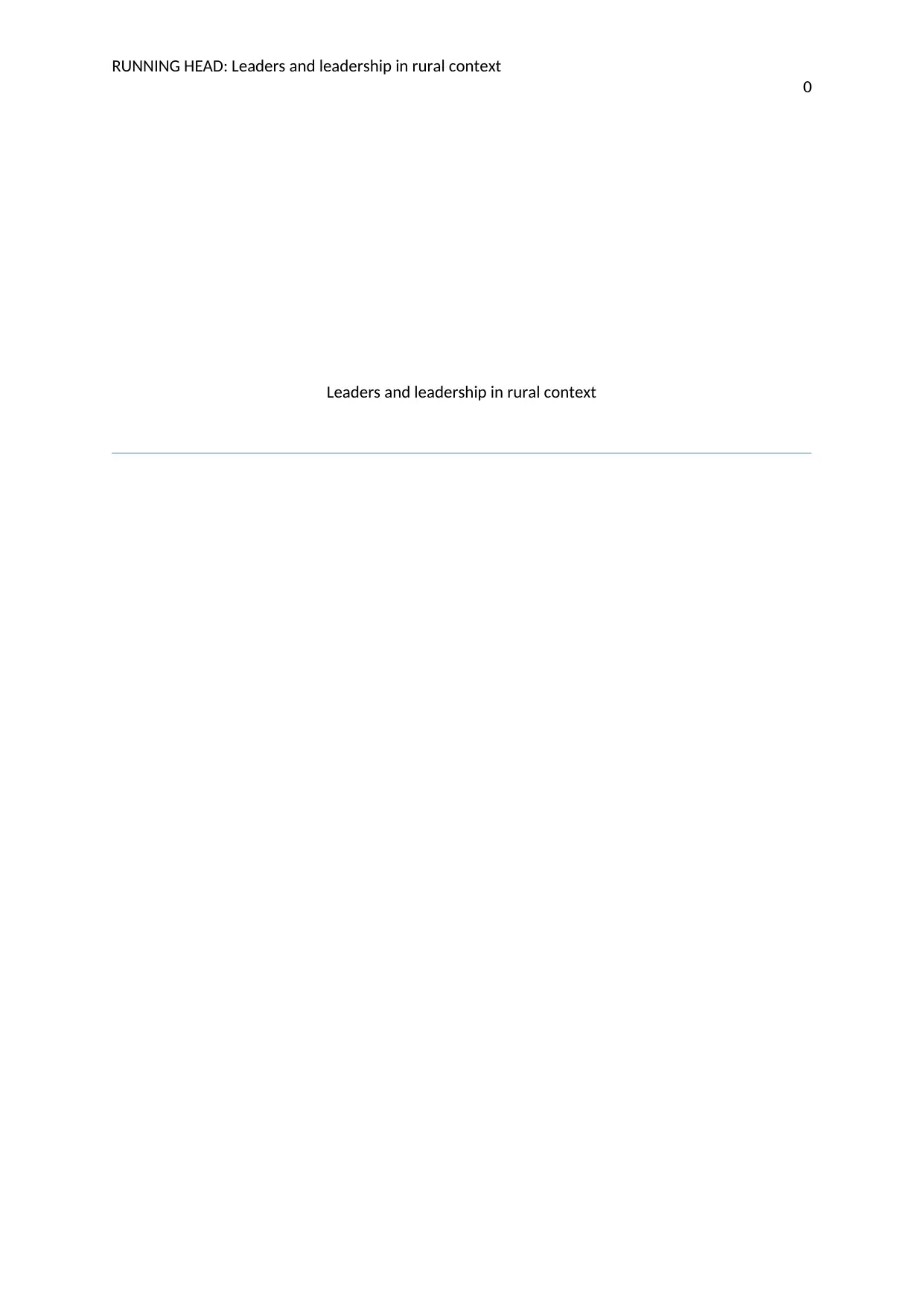
RUNNING HEAD: Leaders and leadership in rural context
0
Leaders and leadership in rural context
0
Leaders and leadership in rural context
Paraphrase This Document
Need a fresh take? Get an instant paraphrase of this document with our AI Paraphraser
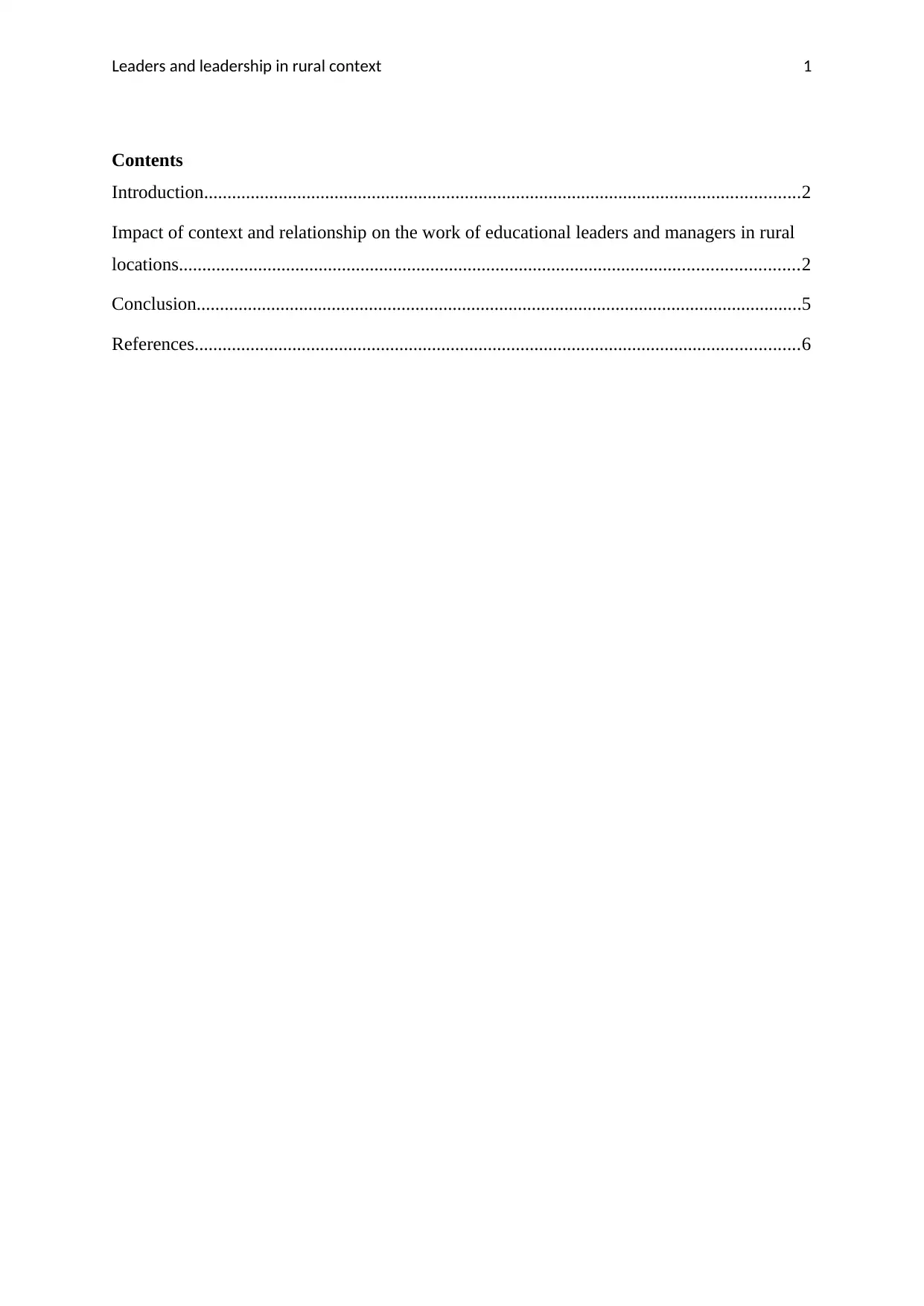
Leaders and leadership in rural context 1
Contents
Introduction................................................................................................................................2
Impact of context and relationship on the work of educational leaders and managers in rural
locations.....................................................................................................................................2
Conclusion..................................................................................................................................5
References..................................................................................................................................6
Contents
Introduction................................................................................................................................2
Impact of context and relationship on the work of educational leaders and managers in rural
locations.....................................................................................................................................2
Conclusion..................................................................................................................................5
References..................................................................................................................................6
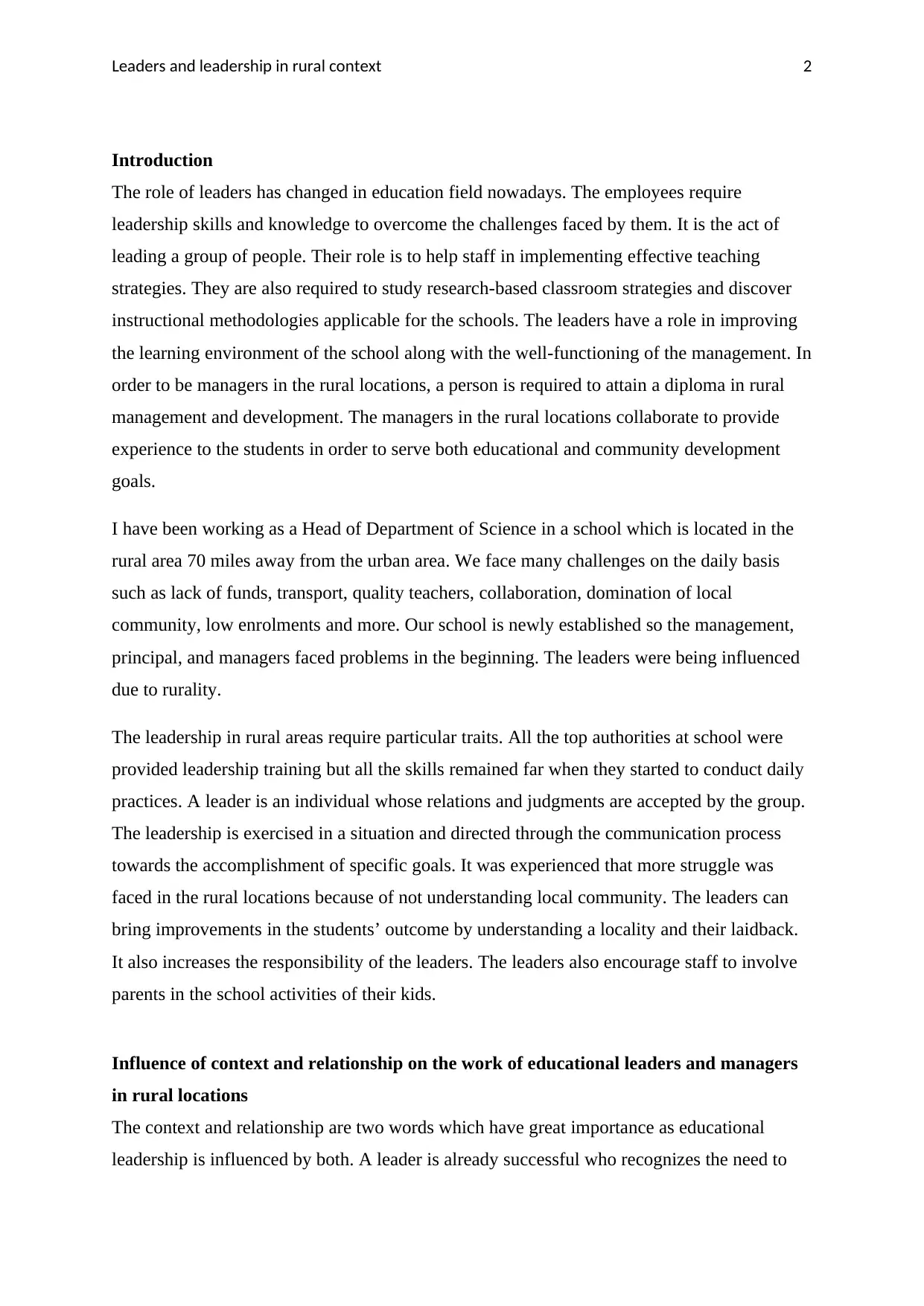
Leaders and leadership in rural context 2
Introduction
The role of leaders has changed in education field nowadays. The employees require
leadership skills and knowledge to overcome the challenges faced by them. It is the act of
leading a group of people. Their role is to help staff in implementing effective teaching
strategies. They are also required to study research-based classroom strategies and discover
instructional methodologies applicable for the schools. The leaders have a role in improving
the learning environment of the school along with the well-functioning of the management. In
order to be managers in the rural locations, a person is required to attain a diploma in rural
management and development. The managers in the rural locations collaborate to provide
experience to the students in order to serve both educational and community development
goals.
I have been working as a Head of Department of Science in a school which is located in the
rural area 70 miles away from the urban area. We face many challenges on the daily basis
such as lack of funds, transport, quality teachers, collaboration, domination of local
community, low enrolments and more. Our school is newly established so the management,
principal, and managers faced problems in the beginning. The leaders were being influenced
due to rurality.
The leadership in rural areas require particular traits. All the top authorities at school were
provided leadership training but all the skills remained far when they started to conduct daily
practices. A leader is an individual whose relations and judgments are accepted by the group.
The leadership is exercised in a situation and directed through the communication process
towards the accomplishment of specific goals. It was experienced that more struggle was
faced in the rural locations because of not understanding local community. The leaders can
bring improvements in the students’ outcome by understanding a locality and their laidback.
It also increases the responsibility of the leaders. The leaders also encourage staff to involve
parents in the school activities of their kids.
Influence of context and relationship on the work of educational leaders and managers
in rural locations
The context and relationship are two words which have great importance as educational
leadership is influenced by both. A leader is already successful who recognizes the need to
Introduction
The role of leaders has changed in education field nowadays. The employees require
leadership skills and knowledge to overcome the challenges faced by them. It is the act of
leading a group of people. Their role is to help staff in implementing effective teaching
strategies. They are also required to study research-based classroom strategies and discover
instructional methodologies applicable for the schools. The leaders have a role in improving
the learning environment of the school along with the well-functioning of the management. In
order to be managers in the rural locations, a person is required to attain a diploma in rural
management and development. The managers in the rural locations collaborate to provide
experience to the students in order to serve both educational and community development
goals.
I have been working as a Head of Department of Science in a school which is located in the
rural area 70 miles away from the urban area. We face many challenges on the daily basis
such as lack of funds, transport, quality teachers, collaboration, domination of local
community, low enrolments and more. Our school is newly established so the management,
principal, and managers faced problems in the beginning. The leaders were being influenced
due to rurality.
The leadership in rural areas require particular traits. All the top authorities at school were
provided leadership training but all the skills remained far when they started to conduct daily
practices. A leader is an individual whose relations and judgments are accepted by the group.
The leadership is exercised in a situation and directed through the communication process
towards the accomplishment of specific goals. It was experienced that more struggle was
faced in the rural locations because of not understanding local community. The leaders can
bring improvements in the students’ outcome by understanding a locality and their laidback.
It also increases the responsibility of the leaders. The leaders also encourage staff to involve
parents in the school activities of their kids.
Influence of context and relationship on the work of educational leaders and managers
in rural locations
The context and relationship are two words which have great importance as educational
leadership is influenced by both. A leader is already successful who recognizes the need to
⊘ This is a preview!⊘
Do you want full access?
Subscribe today to unlock all pages.

Trusted by 1+ million students worldwide
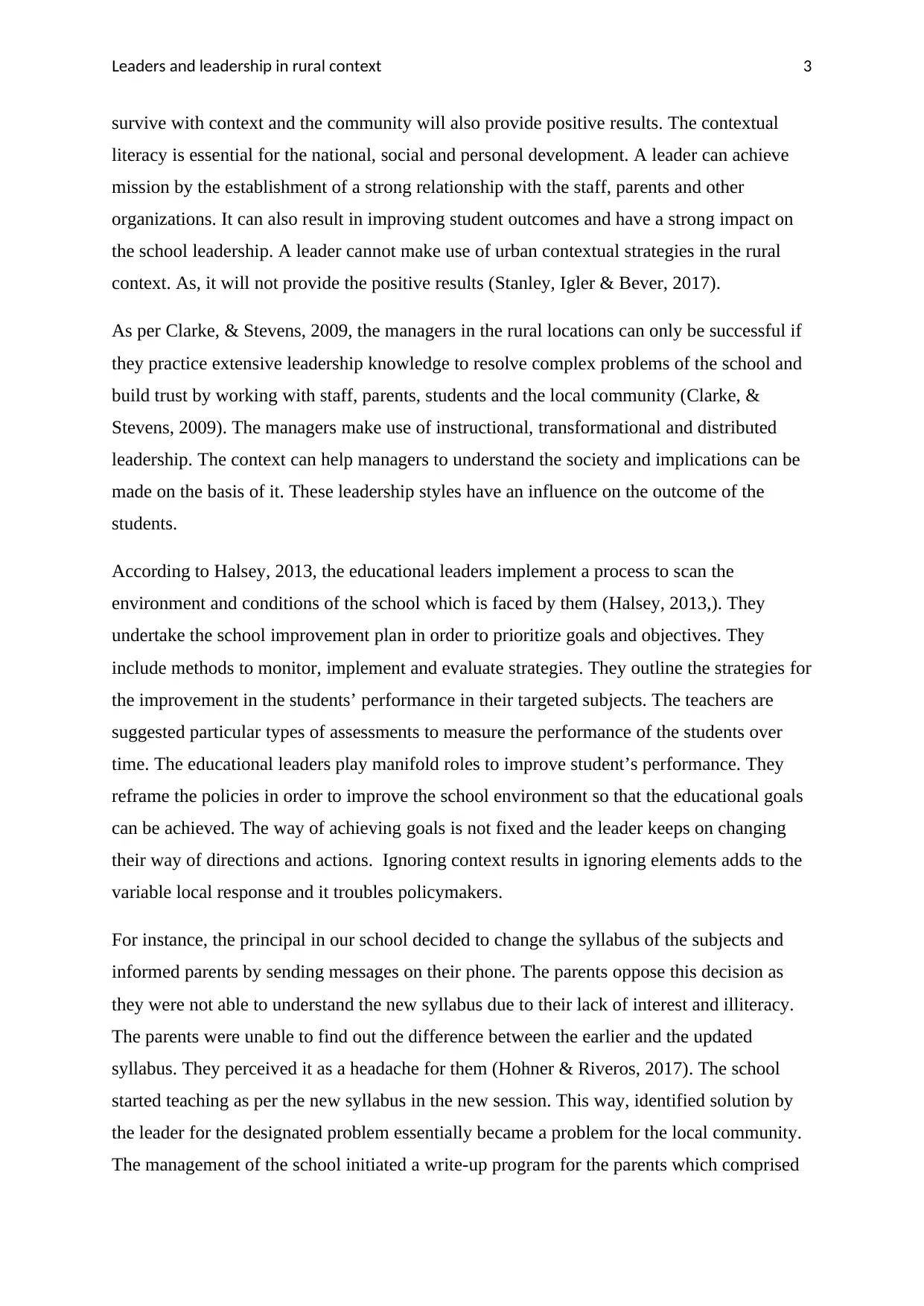
Leaders and leadership in rural context 3
survive with context and the community will also provide positive results. The contextual
literacy is essential for the national, social and personal development. A leader can achieve
mission by the establishment of a strong relationship with the staff, parents and other
organizations. It can also result in improving student outcomes and have a strong impact on
the school leadership. A leader cannot make use of urban contextual strategies in the rural
context. As, it will not provide the positive results (Stanley, Igler & Bever, 2017).
As per Clarke, & Stevens, 2009, the managers in the rural locations can only be successful if
they practice extensive leadership knowledge to resolve complex problems of the school and
build trust by working with staff, parents, students and the local community (Clarke, &
Stevens, 2009). The managers make use of instructional, transformational and distributed
leadership. The context can help managers to understand the society and implications can be
made on the basis of it. These leadership styles have an influence on the outcome of the
students.
According to Halsey, 2013, the educational leaders implement a process to scan the
environment and conditions of the school which is faced by them (Halsey, 2013,). They
undertake the school improvement plan in order to prioritize goals and objectives. They
include methods to monitor, implement and evaluate strategies. They outline the strategies for
the improvement in the students’ performance in their targeted subjects. The teachers are
suggested particular types of assessments to measure the performance of the students over
time. The educational leaders play manifold roles to improve student’s performance. They
reframe the policies in order to improve the school environment so that the educational goals
can be achieved. The way of achieving goals is not fixed and the leader keeps on changing
their way of directions and actions. Ignoring context results in ignoring elements adds to the
variable local response and it troubles policymakers.
For instance, the principal in our school decided to change the syllabus of the subjects and
informed parents by sending messages on their phone. The parents oppose this decision as
they were not able to understand the new syllabus due to their lack of interest and illiteracy.
The parents were unable to find out the difference between the earlier and the updated
syllabus. They perceived it as a headache for them (Hohner & Riveros, 2017). The school
started teaching as per the new syllabus in the new session. This way, identified solution by
the leader for the designated problem essentially became a problem for the local community.
The management of the school initiated a write-up program for the parents which comprised
survive with context and the community will also provide positive results. The contextual
literacy is essential for the national, social and personal development. A leader can achieve
mission by the establishment of a strong relationship with the staff, parents and other
organizations. It can also result in improving student outcomes and have a strong impact on
the school leadership. A leader cannot make use of urban contextual strategies in the rural
context. As, it will not provide the positive results (Stanley, Igler & Bever, 2017).
As per Clarke, & Stevens, 2009, the managers in the rural locations can only be successful if
they practice extensive leadership knowledge to resolve complex problems of the school and
build trust by working with staff, parents, students and the local community (Clarke, &
Stevens, 2009). The managers make use of instructional, transformational and distributed
leadership. The context can help managers to understand the society and implications can be
made on the basis of it. These leadership styles have an influence on the outcome of the
students.
According to Halsey, 2013, the educational leaders implement a process to scan the
environment and conditions of the school which is faced by them (Halsey, 2013,). They
undertake the school improvement plan in order to prioritize goals and objectives. They
include methods to monitor, implement and evaluate strategies. They outline the strategies for
the improvement in the students’ performance in their targeted subjects. The teachers are
suggested particular types of assessments to measure the performance of the students over
time. The educational leaders play manifold roles to improve student’s performance. They
reframe the policies in order to improve the school environment so that the educational goals
can be achieved. The way of achieving goals is not fixed and the leader keeps on changing
their way of directions and actions. Ignoring context results in ignoring elements adds to the
variable local response and it troubles policymakers.
For instance, the principal in our school decided to change the syllabus of the subjects and
informed parents by sending messages on their phone. The parents oppose this decision as
they were not able to understand the new syllabus due to their lack of interest and illiteracy.
The parents were unable to find out the difference between the earlier and the updated
syllabus. They perceived it as a headache for them (Hohner & Riveros, 2017). The school
started teaching as per the new syllabus in the new session. This way, identified solution by
the leader for the designated problem essentially became a problem for the local community.
The management of the school initiated a write-up program for the parents which comprised
Paraphrase This Document
Need a fresh take? Get an instant paraphrase of this document with our AI Paraphraser
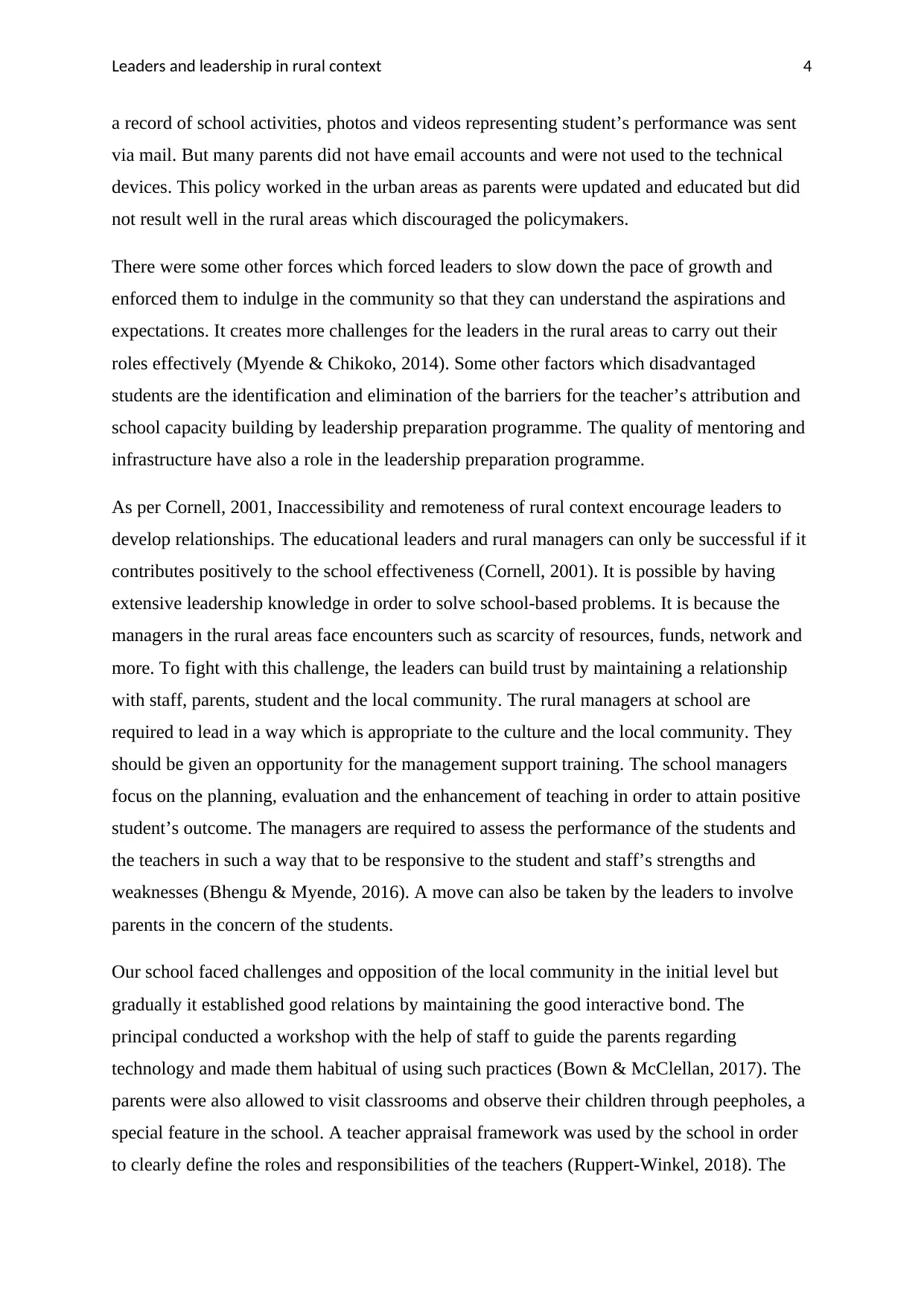
Leaders and leadership in rural context 4
a record of school activities, photos and videos representing student’s performance was sent
via mail. But many parents did not have email accounts and were not used to the technical
devices. This policy worked in the urban areas as parents were updated and educated but did
not result well in the rural areas which discouraged the policymakers.
There were some other forces which forced leaders to slow down the pace of growth and
enforced them to indulge in the community so that they can understand the aspirations and
expectations. It creates more challenges for the leaders in the rural areas to carry out their
roles effectively (Myende & Chikoko, 2014). Some other factors which disadvantaged
students are the identification and elimination of the barriers for the teacher’s attribution and
school capacity building by leadership preparation programme. The quality of mentoring and
infrastructure have also a role in the leadership preparation programme.
As per Cornell, 2001, Inaccessibility and remoteness of rural context encourage leaders to
develop relationships. The educational leaders and rural managers can only be successful if it
contributes positively to the school effectiveness (Cornell, 2001). It is possible by having
extensive leadership knowledge in order to solve school-based problems. It is because the
managers in the rural areas face encounters such as scarcity of resources, funds, network and
more. To fight with this challenge, the leaders can build trust by maintaining a relationship
with staff, parents, student and the local community. The rural managers at school are
required to lead in a way which is appropriate to the culture and the local community. They
should be given an opportunity for the management support training. The school managers
focus on the planning, evaluation and the enhancement of teaching in order to attain positive
student’s outcome. The managers are required to assess the performance of the students and
the teachers in such a way that to be responsive to the student and staff’s strengths and
weaknesses (Bhengu & Myende, 2016). A move can also be taken by the leaders to involve
parents in the concern of the students.
Our school faced challenges and opposition of the local community in the initial level but
gradually it established good relations by maintaining the good interactive bond. The
principal conducted a workshop with the help of staff to guide the parents regarding
technology and made them habitual of using such practices (Bown & McClellan, 2017). The
parents were also allowed to visit classrooms and observe their children through peepholes, a
special feature in the school. A teacher appraisal framework was used by the school in order
to clearly define the roles and responsibilities of the teachers (Ruppert-Winkel, 2018). The
a record of school activities, photos and videos representing student’s performance was sent
via mail. But many parents did not have email accounts and were not used to the technical
devices. This policy worked in the urban areas as parents were updated and educated but did
not result well in the rural areas which discouraged the policymakers.
There were some other forces which forced leaders to slow down the pace of growth and
enforced them to indulge in the community so that they can understand the aspirations and
expectations. It creates more challenges for the leaders in the rural areas to carry out their
roles effectively (Myende & Chikoko, 2014). Some other factors which disadvantaged
students are the identification and elimination of the barriers for the teacher’s attribution and
school capacity building by leadership preparation programme. The quality of mentoring and
infrastructure have also a role in the leadership preparation programme.
As per Cornell, 2001, Inaccessibility and remoteness of rural context encourage leaders to
develop relationships. The educational leaders and rural managers can only be successful if it
contributes positively to the school effectiveness (Cornell, 2001). It is possible by having
extensive leadership knowledge in order to solve school-based problems. It is because the
managers in the rural areas face encounters such as scarcity of resources, funds, network and
more. To fight with this challenge, the leaders can build trust by maintaining a relationship
with staff, parents, student and the local community. The rural managers at school are
required to lead in a way which is appropriate to the culture and the local community. They
should be given an opportunity for the management support training. The school managers
focus on the planning, evaluation and the enhancement of teaching in order to attain positive
student’s outcome. The managers are required to assess the performance of the students and
the teachers in such a way that to be responsive to the student and staff’s strengths and
weaknesses (Bhengu & Myende, 2016). A move can also be taken by the leaders to involve
parents in the concern of the students.
Our school faced challenges and opposition of the local community in the initial level but
gradually it established good relations by maintaining the good interactive bond. The
principal conducted a workshop with the help of staff to guide the parents regarding
technology and made them habitual of using such practices (Bown & McClellan, 2017). The
parents were also allowed to visit classrooms and observe their children through peepholes, a
special feature in the school. A teacher appraisal framework was used by the school in order
to clearly define the roles and responsibilities of the teachers (Ruppert-Winkel, 2018). The
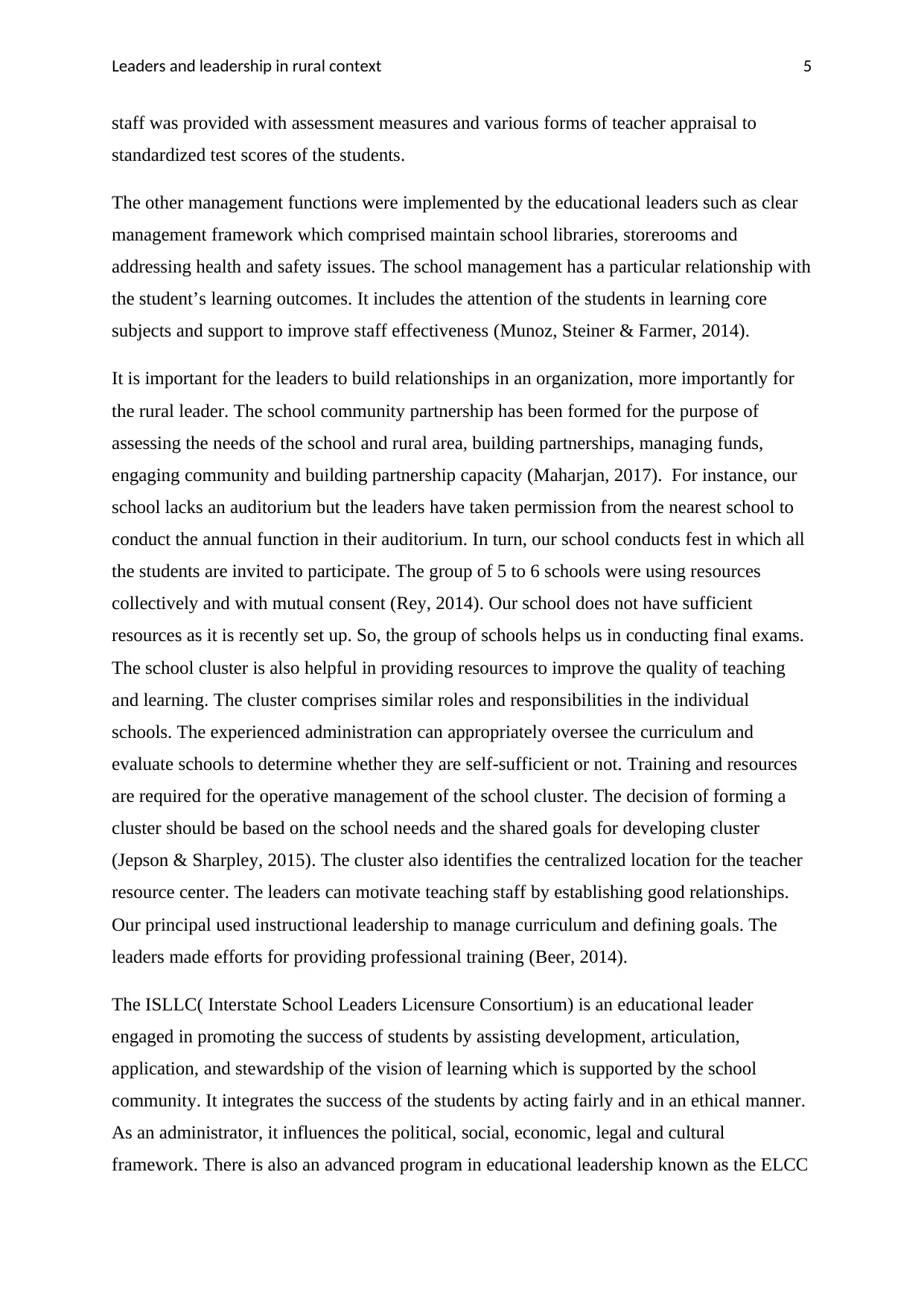
Leaders and leadership in rural context 5
staff was provided with assessment measures and various forms of teacher appraisal to
standardized test scores of the students.
The other management functions were implemented by the educational leaders such as clear
management framework which comprised maintain school libraries, storerooms and
addressing health and safety issues. The school management has a particular relationship with
the student’s learning outcomes. It includes the attention of the students in learning core
subjects and support to improve staff effectiveness (Munoz, Steiner & Farmer, 2014).
It is important for the leaders to build relationships in an organization, more importantly for
the rural leader. The school community partnership has been formed for the purpose of
assessing the needs of the school and rural area, building partnerships, managing funds,
engaging community and building partnership capacity (Maharjan, 2017). For instance, our
school lacks an auditorium but the leaders have taken permission from the nearest school to
conduct the annual function in their auditorium. In turn, our school conducts fest in which all
the students are invited to participate. The group of 5 to 6 schools were using resources
collectively and with mutual consent (Rey, 2014). Our school does not have sufficient
resources as it is recently set up. So, the group of schools helps us in conducting final exams.
The school cluster is also helpful in providing resources to improve the quality of teaching
and learning. The cluster comprises similar roles and responsibilities in the individual
schools. The experienced administration can appropriately oversee the curriculum and
evaluate schools to determine whether they are self-sufficient or not. Training and resources
are required for the operative management of the school cluster. The decision of forming a
cluster should be based on the school needs and the shared goals for developing cluster
(Jepson & Sharpley, 2015). The cluster also identifies the centralized location for the teacher
resource center. The leaders can motivate teaching staff by establishing good relationships.
Our principal used instructional leadership to manage curriculum and defining goals. The
leaders made efforts for providing professional training (Beer, 2014).
The ISLLC( Interstate School Leaders Licensure Consortium) is an educational leader
engaged in promoting the success of students by assisting development, articulation,
application, and stewardship of the vision of learning which is supported by the school
community. It integrates the success of the students by acting fairly and in an ethical manner.
As an administrator, it influences the political, social, economic, legal and cultural
framework. There is also an advanced program in educational leadership known as the ELCC
staff was provided with assessment measures and various forms of teacher appraisal to
standardized test scores of the students.
The other management functions were implemented by the educational leaders such as clear
management framework which comprised maintain school libraries, storerooms and
addressing health and safety issues. The school management has a particular relationship with
the student’s learning outcomes. It includes the attention of the students in learning core
subjects and support to improve staff effectiveness (Munoz, Steiner & Farmer, 2014).
It is important for the leaders to build relationships in an organization, more importantly for
the rural leader. The school community partnership has been formed for the purpose of
assessing the needs of the school and rural area, building partnerships, managing funds,
engaging community and building partnership capacity (Maharjan, 2017). For instance, our
school lacks an auditorium but the leaders have taken permission from the nearest school to
conduct the annual function in their auditorium. In turn, our school conducts fest in which all
the students are invited to participate. The group of 5 to 6 schools were using resources
collectively and with mutual consent (Rey, 2014). Our school does not have sufficient
resources as it is recently set up. So, the group of schools helps us in conducting final exams.
The school cluster is also helpful in providing resources to improve the quality of teaching
and learning. The cluster comprises similar roles and responsibilities in the individual
schools. The experienced administration can appropriately oversee the curriculum and
evaluate schools to determine whether they are self-sufficient or not. Training and resources
are required for the operative management of the school cluster. The decision of forming a
cluster should be based on the school needs and the shared goals for developing cluster
(Jepson & Sharpley, 2015). The cluster also identifies the centralized location for the teacher
resource center. The leaders can motivate teaching staff by establishing good relationships.
Our principal used instructional leadership to manage curriculum and defining goals. The
leaders made efforts for providing professional training (Beer, 2014).
The ISLLC( Interstate School Leaders Licensure Consortium) is an educational leader
engaged in promoting the success of students by assisting development, articulation,
application, and stewardship of the vision of learning which is supported by the school
community. It integrates the success of the students by acting fairly and in an ethical manner.
As an administrator, it influences the political, social, economic, legal and cultural
framework. There is also an advanced program in educational leadership known as the ELCC
⊘ This is a preview!⊘
Do you want full access?
Subscribe today to unlock all pages.

Trusted by 1+ million students worldwide
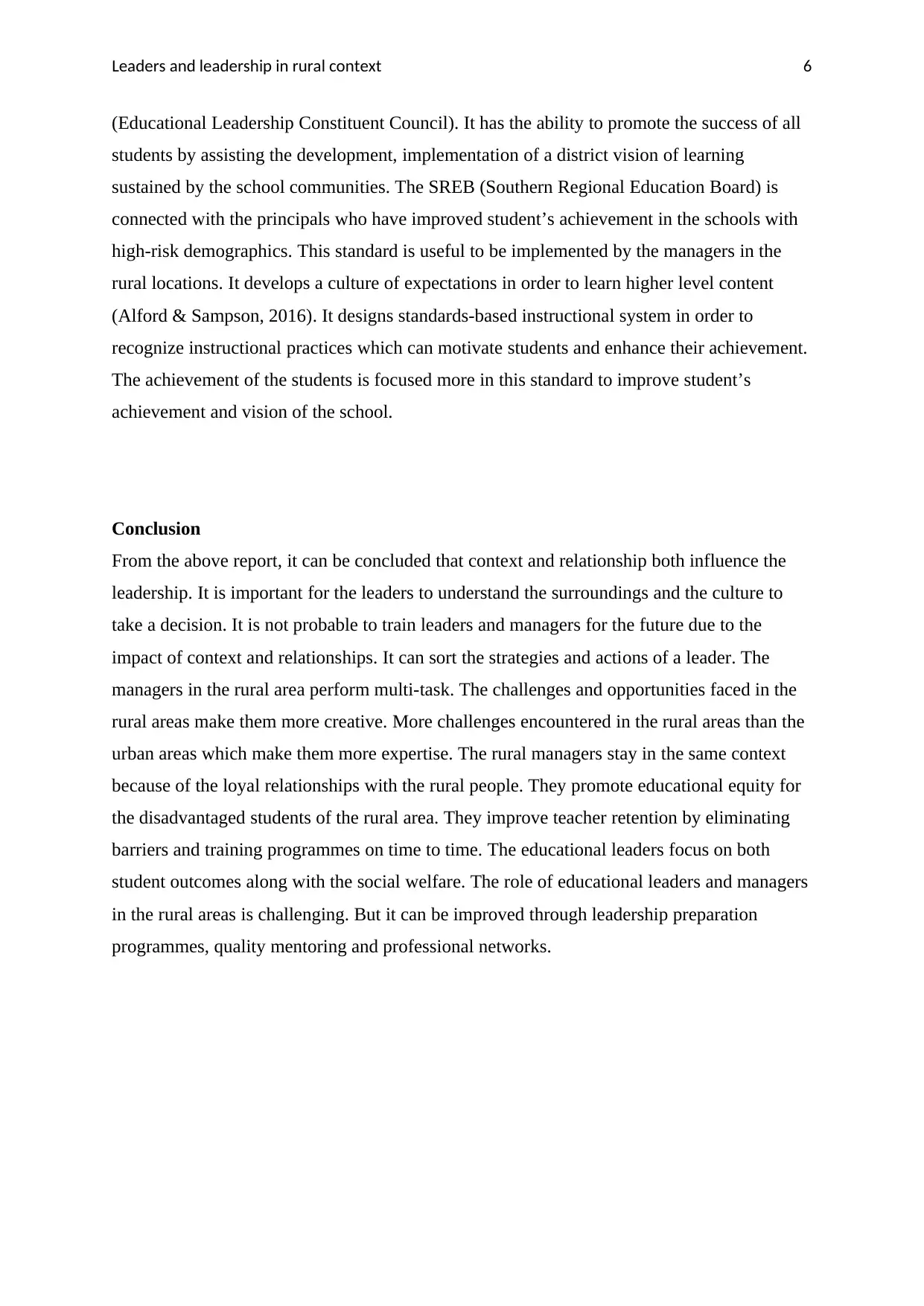
Leaders and leadership in rural context 6
(Educational Leadership Constituent Council). It has the ability to promote the success of all
students by assisting the development, implementation of a district vision of learning
sustained by the school communities. The SREB (Southern Regional Education Board) is
connected with the principals who have improved student’s achievement in the schools with
high-risk demographics. This standard is useful to be implemented by the managers in the
rural locations. It develops a culture of expectations in order to learn higher level content
(Alford & Sampson, 2016). It designs standards-based instructional system in order to
recognize instructional practices which can motivate students and enhance their achievement.
The achievement of the students is focused more in this standard to improve student’s
achievement and vision of the school.
Conclusion
From the above report, it can be concluded that context and relationship both influence the
leadership. It is important for the leaders to understand the surroundings and the culture to
take a decision. It is not probable to train leaders and managers for the future due to the
impact of context and relationships. It can sort the strategies and actions of a leader. The
managers in the rural area perform multi-task. The challenges and opportunities faced in the
rural areas make them more creative. More challenges encountered in the rural areas than the
urban areas which make them more expertise. The rural managers stay in the same context
because of the loyal relationships with the rural people. They promote educational equity for
the disadvantaged students of the rural area. They improve teacher retention by eliminating
barriers and training programmes on time to time. The educational leaders focus on both
student outcomes along with the social welfare. The role of educational leaders and managers
in the rural areas is challenging. But it can be improved through leadership preparation
programmes, quality mentoring and professional networks.
(Educational Leadership Constituent Council). It has the ability to promote the success of all
students by assisting the development, implementation of a district vision of learning
sustained by the school communities. The SREB (Southern Regional Education Board) is
connected with the principals who have improved student’s achievement in the schools with
high-risk demographics. This standard is useful to be implemented by the managers in the
rural locations. It develops a culture of expectations in order to learn higher level content
(Alford & Sampson, 2016). It designs standards-based instructional system in order to
recognize instructional practices which can motivate students and enhance their achievement.
The achievement of the students is focused more in this standard to improve student’s
achievement and vision of the school.
Conclusion
From the above report, it can be concluded that context and relationship both influence the
leadership. It is important for the leaders to understand the surroundings and the culture to
take a decision. It is not probable to train leaders and managers for the future due to the
impact of context and relationships. It can sort the strategies and actions of a leader. The
managers in the rural area perform multi-task. The challenges and opportunities faced in the
rural areas make them more creative. More challenges encountered in the rural areas than the
urban areas which make them more expertise. The rural managers stay in the same context
because of the loyal relationships with the rural people. They promote educational equity for
the disadvantaged students of the rural area. They improve teacher retention by eliminating
barriers and training programmes on time to time. The educational leaders focus on both
student outcomes along with the social welfare. The role of educational leaders and managers
in the rural areas is challenging. But it can be improved through leadership preparation
programmes, quality mentoring and professional networks.
Paraphrase This Document
Need a fresh take? Get an instant paraphrase of this document with our AI Paraphraser
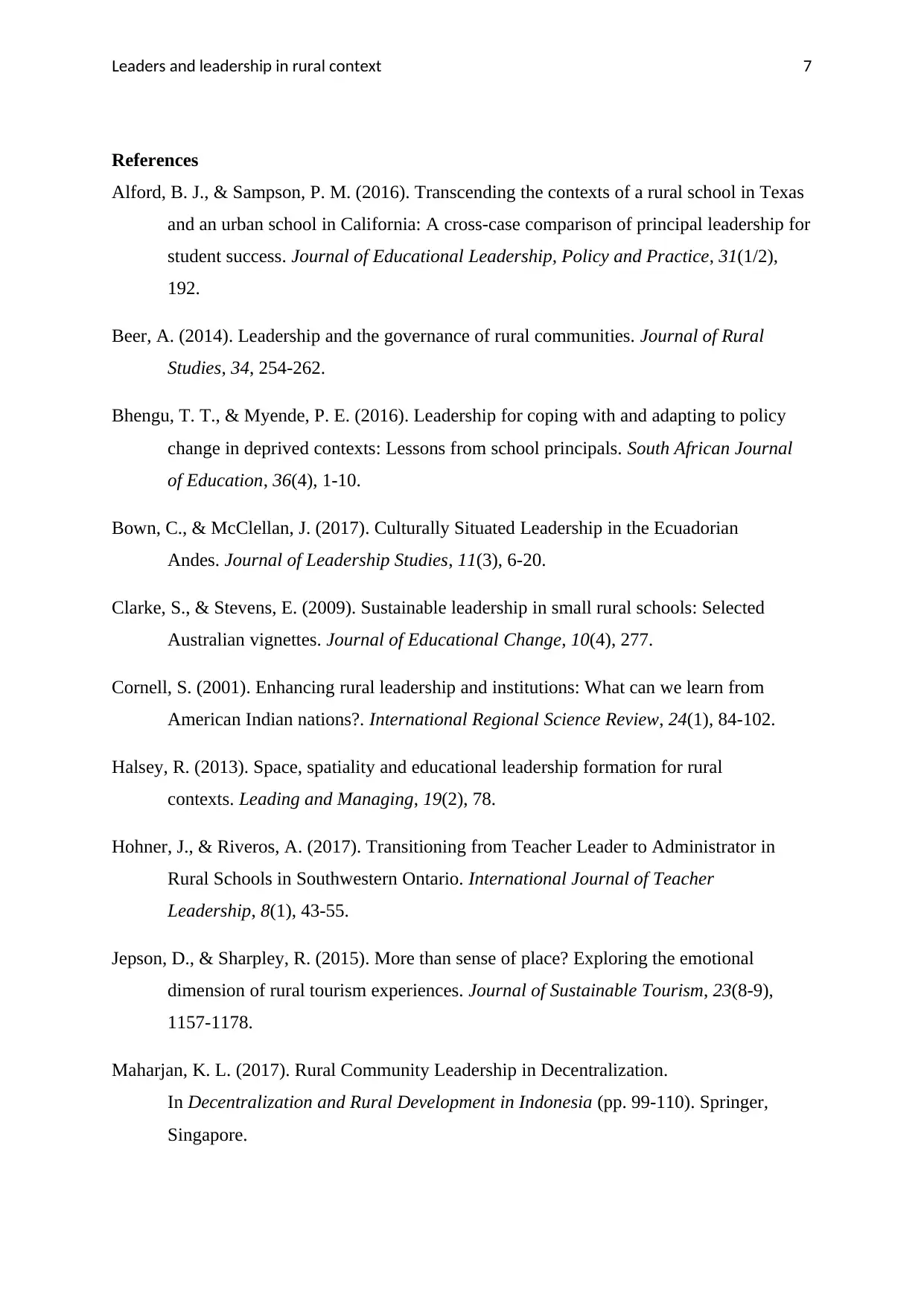
Leaders and leadership in rural context 7
References
Alford, B. J., & Sampson, P. M. (2016). Transcending the contexts of a rural school in Texas
and an urban school in California: A cross-case comparison of principal leadership for
student success. Journal of Educational Leadership, Policy and Practice, 31(1/2),
192.
Beer, A. (2014). Leadership and the governance of rural communities. Journal of Rural
Studies, 34, 254-262.
Bhengu, T. T., & Myende, P. E. (2016). Leadership for coping with and adapting to policy
change in deprived contexts: Lessons from school principals. South African Journal
of Education, 36(4), 1-10.
Bown, C., & McClellan, J. (2017). Culturally Situated Leadership in the Ecuadorian
Andes. Journal of Leadership Studies, 11(3), 6-20.
Clarke, S., & Stevens, E. (2009). Sustainable leadership in small rural schools: Selected
Australian vignettes. Journal of Educational Change, 10(4), 277.
Cornell, S. (2001). Enhancing rural leadership and institutions: What can we learn from
American Indian nations?. International Regional Science Review, 24(1), 84-102.
Halsey, R. (2013). Space, spatiality and educational leadership formation for rural
contexts. Leading and Managing, 19(2), 78.
Hohner, J., & Riveros, A. (2017). Transitioning from Teacher Leader to Administrator in
Rural Schools in Southwestern Ontario. International Journal of Teacher
Leadership, 8(1), 43-55.
Jepson, D., & Sharpley, R. (2015). More than sense of place? Exploring the emotional
dimension of rural tourism experiences. Journal of Sustainable Tourism, 23(8-9),
1157-1178.
Maharjan, K. L. (2017). Rural Community Leadership in Decentralization.
In Decentralization and Rural Development in Indonesia (pp. 99-110). Springer,
Singapore.
References
Alford, B. J., & Sampson, P. M. (2016). Transcending the contexts of a rural school in Texas
and an urban school in California: A cross-case comparison of principal leadership for
student success. Journal of Educational Leadership, Policy and Practice, 31(1/2),
192.
Beer, A. (2014). Leadership and the governance of rural communities. Journal of Rural
Studies, 34, 254-262.
Bhengu, T. T., & Myende, P. E. (2016). Leadership for coping with and adapting to policy
change in deprived contexts: Lessons from school principals. South African Journal
of Education, 36(4), 1-10.
Bown, C., & McClellan, J. (2017). Culturally Situated Leadership in the Ecuadorian
Andes. Journal of Leadership Studies, 11(3), 6-20.
Clarke, S., & Stevens, E. (2009). Sustainable leadership in small rural schools: Selected
Australian vignettes. Journal of Educational Change, 10(4), 277.
Cornell, S. (2001). Enhancing rural leadership and institutions: What can we learn from
American Indian nations?. International Regional Science Review, 24(1), 84-102.
Halsey, R. (2013). Space, spatiality and educational leadership formation for rural
contexts. Leading and Managing, 19(2), 78.
Hohner, J., & Riveros, A. (2017). Transitioning from Teacher Leader to Administrator in
Rural Schools in Southwestern Ontario. International Journal of Teacher
Leadership, 8(1), 43-55.
Jepson, D., & Sharpley, R. (2015). More than sense of place? Exploring the emotional
dimension of rural tourism experiences. Journal of Sustainable Tourism, 23(8-9),
1157-1178.
Maharjan, K. L. (2017). Rural Community Leadership in Decentralization.
In Decentralization and Rural Development in Indonesia (pp. 99-110). Springer,
Singapore.
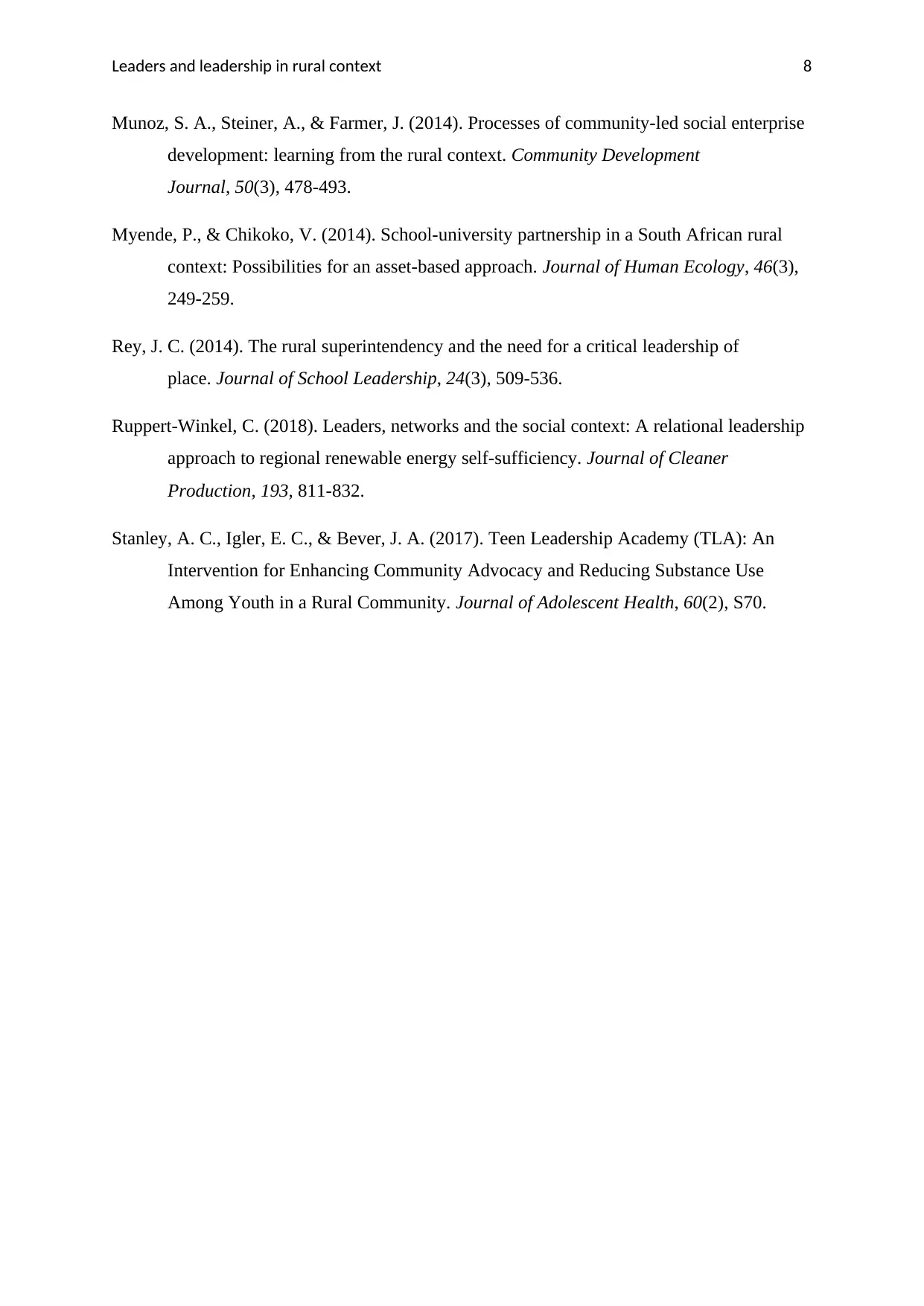
Leaders and leadership in rural context 8
Munoz, S. A., Steiner, A., & Farmer, J. (2014). Processes of community-led social enterprise
development: learning from the rural context. Community Development
Journal, 50(3), 478-493.
Myende, P., & Chikoko, V. (2014). School-university partnership in a South African rural
context: Possibilities for an asset-based approach. Journal of Human Ecology, 46(3),
249-259.
Rey, J. C. (2014). The rural superintendency and the need for a critical leadership of
place. Journal of School Leadership, 24(3), 509-536.
Ruppert-Winkel, C. (2018). Leaders, networks and the social context: A relational leadership
approach to regional renewable energy self-sufficiency. Journal of Cleaner
Production, 193, 811-832.
Stanley, A. C., Igler, E. C., & Bever, J. A. (2017). Teen Leadership Academy (TLA): An
Intervention for Enhancing Community Advocacy and Reducing Substance Use
Among Youth in a Rural Community. Journal of Adolescent Health, 60(2), S70.
Munoz, S. A., Steiner, A., & Farmer, J. (2014). Processes of community-led social enterprise
development: learning from the rural context. Community Development
Journal, 50(3), 478-493.
Myende, P., & Chikoko, V. (2014). School-university partnership in a South African rural
context: Possibilities for an asset-based approach. Journal of Human Ecology, 46(3),
249-259.
Rey, J. C. (2014). The rural superintendency and the need for a critical leadership of
place. Journal of School Leadership, 24(3), 509-536.
Ruppert-Winkel, C. (2018). Leaders, networks and the social context: A relational leadership
approach to regional renewable energy self-sufficiency. Journal of Cleaner
Production, 193, 811-832.
Stanley, A. C., Igler, E. C., & Bever, J. A. (2017). Teen Leadership Academy (TLA): An
Intervention for Enhancing Community Advocacy and Reducing Substance Use
Among Youth in a Rural Community. Journal of Adolescent Health, 60(2), S70.
⊘ This is a preview!⊘
Do you want full access?
Subscribe today to unlock all pages.

Trusted by 1+ million students worldwide
1 out of 9
Related Documents
Your All-in-One AI-Powered Toolkit for Academic Success.
+13062052269
info@desklib.com
Available 24*7 on WhatsApp / Email
![[object Object]](/_next/static/media/star-bottom.7253800d.svg)
Unlock your academic potential
Copyright © 2020–2025 A2Z Services. All Rights Reserved. Developed and managed by ZUCOL.





